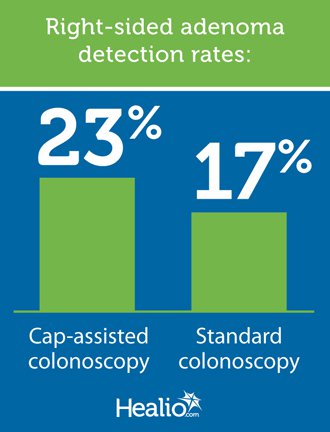Cap-assisted Colonoscopy Improves Detection of Proximal Colon Adenomas

The use of cap-assisted colonoscopy significantly improves adenoma detection rate in the proximal colon, according to the results of a systematic review and meta-analysis.
Investigators also found cap-assisted colonoscopy significantly improved detection of flat adenoma and serrated colonic lesions compared with standard colonoscopy.
“Cap-assisted colonoscopy (CC) is a technique that uses a transparent cap or hood attached to the tip of the colonoscope that flattens the mucosal folds and improves visibility of polyps situated proximal to them,” Prateek Sharma, MD, professor of medicine in the department of gastroenterology, hepatology and motility at University of Kansas Medical Center and the Kansas VA Medical Center, and colleagues wrote. “These are the so-called blind spots where polyps can be commonly missed.”
To compare pooled rates of adenoma detection rates (ADRs) for right-sided or proximal colon adenomas for CC vs. standard colonoscopy, Sharma and colleagues reviewed relevant medical literature published up to October 2016, and included four studies reporting right-sided ADRs (n = 2,546 for CC; 2,547 for standard colonoscopy) and six studies reporting right-sided ADRs per patient (n = 3,159 for CC; 3,137 for standard colonoscopy).
They found that CC detected right-sided adenomas in 6% more patients than standard colonoscopy. Right-sided ADRs were significantly higher in patients who underwent CC compared with those who underwent standard colonoscopy (23% vs. 17%; OR = 1.49; 95% CI, 1.08-2.05).

They also found that CC resulted in significantly better detections rates for flat adenomas (OR = 2.08; 95% CI, 1.35-3.2) and sessile serrated adenomas or polyps (OR = 1.33; 95% CI, 1.01-1.74).
However, the total number of right-sided adenomas overall (1,428 [60% of all adenomas] vs. 1,127 [58%]) and adenomas per patient (mean, 0.71 vs. 0.65) were numerically higher for CC, but these were not significant differences.
The investigators estimated that the number needed to treat was 16.7%, meaning 17 colonoscopies using a distal cap attachment would be needed to detect an additional patient with at least one right-sided adenoma.
“This may pave the way for future use of the cap to improve detection of right-sided lesions, to improve [right-sided] ADRs, and to improve the quality of colonoscopy with the ultimate hope of reducing the incidence of right-sided colon cancer,” Sharma and colleagues concluded. – by Adam Leitenberger
Disclosures: The researchers report no relevant financial disclosures.
